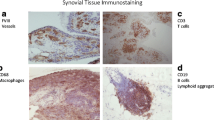Abstract
Objectives
Generation of advanced glycation end products (AGE) is an inevitable process in vivo and can be accelerated under pathologic conditions such as oxidative stress, e.g. in rheumatoid arthritis (RA). This process is mediated by the AGE-specific receptor (RAGE). In this study we analysed the presence of RAGE in RA and osteoarthritic (OA) synovial tissue using immunohistology.
Methods
Frozen synovial tissue samples from 11 RA patients and 12 OA patients were treated with goat anti-RAGE immunoglobulin G (IgG) and rabbit antigoat IgG. Immunostaining was visualised with streptavidin horse radish peroxidase (chromogen amino-ethyl-carbazole). Cell differentiation was performed with antibodies against CD68, CD45RO, and CD20.
Results
In 9/11 RA and 8/12 OA synovial specimens, RAGE was detected in synovial lining, sublining, and stroma. In RA, many T cells (CD45RO+) and some macrophages (CD68+) showed positive immunostaining for RAGE, whereas B cells were mostly negative. We found no difference in staining patterns between the RA and OA samples.
Conclusions
We detected RAGE in RA and OA synovial tissue. The presence of RAGE on macrophages, T cells, and some B cells suggests its role in the pathogenesis of inflammatory joint disease.



Similar content being viewed by others
References
Miyata T, Ishiguro N, Yasuda Y (1998) Increased pentosidine, an advanced glycation end product, in plasma and synovial fluid from patients with rheumatoid arthritis and in relation with inflammatory markers. Biochem Biophys Res Commun 244:49
Takahashi M, Kushida K, Ohishi T (1994) Quantitative analysis of crosslinks pyridinoline and pentosidine in articular cartilage of patients with bone and joint disorders. Arthritis Rheum 37:724–728
Chen JR, Takahashi M, Suzuki M, Kushida S, Miyamoto S, Inoue T (1999) Comparison of the concentrations of pentosidine in the synovial fluid, serum and urine of patients with rheumatoid arthritis and osteoarthritis. Br J Rheum 38:1275–1278
Drinda S, Franke S, Canet CC, Petrow P, Brauer R, Huttich C et al (2002) Identification of the advanced glycation end product N (epsilon) carboxymethyllysine in the synovial tissue of patients with rheumatoid arthritis. Ann Rheum Dis 61:488–492
Arnett FC, Edworthy SM, Bloch DA, McShane DJ, Fries JF, Cooper NS et al (1988) The American Rheumatism Association 1987 revised criteria for the classification of rheumatoid arthritis. Arthritis Rheum 31:315–324
Vlassara H (1996) Protein glycation in the kidney: role in diabetes and aging. Kidney Int 49:1795–1804
Vlassara H (1996) Advanced glycation end-products and atherosclerosis. Ann Med 28:419–426
Colaco C, Ledesma MD, Harrington CR, Avila J (1996) The role of the Maillard reaction in other pathologies: Alzheimer’s disease. Nephrol Dial Transplant 11:7–12
Miyata M, Iida Y, Horie K, Cai Z, Sugiyama S, Maeda K (1996) Pathophysiology of advanced glycation end-products in renal failure. Nephrol Dial Transplant 1:27–80
Friedlander MA, Wu YC, Elgawish A, Monnier VM (1996) Early and advanced glycosylation end products—kinetics of formation and clearance in peritoneal dialysis. J Clin Invest 97:728–735
McCarthy AD, Etcheverry SB, Bruzzone L, Cortizo AM (1997) Effects of advanced glycation end products on the proliferation and differentiation of osteoblast-like cells. Mol Cell Biochem 170:43–51
Miyata T, Kawai R, Taketomi S, Sprague SM (1996) Possible involvement of advanced glycation end products in bone resorption. Nephrol Dial Transplant 11:54–57
Takagi M, Kasayama S, Yamamoto T (1997) Advanced glycation end products stimulate interleukin 6 production by human bone derived cells. J Bone Miner Res 12:439–446
Kislinger T, Fu C, Huber B, Qu W, Taguchi A, Du Yan S et al (1999) N-carboxymethyllysine adducts of proteins are ligands for receptors for advanced glycation end products that activate cell signaling pathways and modulate gene expression. J Biol Chem 44:31740–31749
Thornalley P (1998) Cell activation by glycated proteins. AGE receptors, receptor recognition factors and functional classification of AGEs. Cell Mol Biol 44:1013–1023
Takahashi M, Suzuki M, Kushida K (1997) Relationship between pentosidine levels in serum and urine and activity in rheumatoid arthritis. Br J Rheum 36:637–642
Stern DM, Yan SD, Yan SF, Schidt AM (2002) Receptor for advanced glycation endproducts (RAGE) and complications of diabetes. Ageing Res Rev 1:1–15
Author information
Authors and Affiliations
Corresponding author
Rights and permissions
About this article
Cite this article
Drinda, S., Franke, S., Rüster, M. et al. Identification of the receptor for advanced glycation end products in synovial tissue of patients with rheumatoid arthritis. Rheumatol Int 25, 411–413 (2005). https://doi.org/10.1007/s00296-004-0456-y
Received:
Accepted:
Published:
Issue Date:
DOI: https://doi.org/10.1007/s00296-004-0456-y




